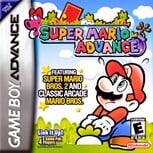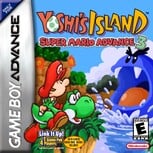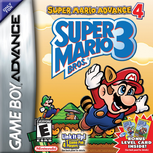Super Mario Advance (series): Difference between revisions
m (→Changes from the original games: "Finalized"? What does that even mean?) |
|||
| Line 55: | Line 55: | ||
== Changes from the original games == | == Changes from the original games == | ||
*In ''Super Mario Advance'', ''Super Mario Advance 2: Super Mario World'' and ''Super Mario Advance 4: Super Mario Bros.3'', [[Princess Toadstool]] is now referred to as by her current standard Peach name which was introduced in ''[[Yoshi's Safari]]'' and retained | *In ''Super Mario Advance'', ''Super Mario Advance 2: Super Mario World'' and ''Super Mario Advance 4: Super Mario Bros.3'', [[Princess Toadstool]] is now referred to as by her current standard Peach name which was introduced in ''[[Yoshi's Safari]]'' and retained in ''[[Super Mario 64]]''. | ||
==Gallery== | ==Gallery== | ||
Revision as of 20:58, November 29, 2014
Template:Series-infobox The Super Mario Advance series is a series of video game remakes released only on the Game Boy Advance. Each game contains one of the classic Mario sidescrollers, with improved graphics, sound, and additional features. Also, each game contains an updated version of the 1983 arcade game Mario Bros. which adds an extra POW Block near the top of the stage. The series finished in 2003 with 4 games.
Multi-player mode
Any game in the Super Mario Advance series or Mario & Luigi: Superstar Saga can link up to other Game Boy Advances that also have any of the said five games. This allows two to four people to play a version of Mario Bros., with better graphics, control, and sound. All players are Marios, but they wear different colored uniforms (red, yellow, green, and blue), though they still have the letter "M" on their caps. Players can pick each other up and throw each other, though a grabbed player can escape another's grasp. In "Classic Mode", the players cooperate in defeating the enemies like in the single player mode. In "Battle Mode", the players start off as Super Marios and compete against each other to collect five coins first by defeating enemies or being the last one standing. An invincible, flame-throwing Bowser appears in bonus rounds.
If there are only two players in the Battle Mode, there will be a trash can at the bottom. Players can be thrown in the trash can. A player in the trash can is stuck there for several seconds, putting them at a disadvantage, but they will come out with an item that helps them fight their rival. Players can receive a useless fishbone, a Koopa shell, a POW Block, or an egg. The egg can yield either a coin, a Star, or a heart which acts like a Super Mushroom.
Games
| Title and Original Release | Overview |
|---|---|
| Super Mario Advance
|
Super Mario Advance features the classic game Super Mario Bros. 2, based heavily on the Super Mario All-Stars port of the game, although in the game it is referred to as Super Mario 2. Nintendo's decision to choose this title as a Game Boy Advance launch game was seen by some as misguided; GameSpot in particular thought that Super Mario Bros. 3 or Super Mario World would have been far better choices for a launch title considering their popularity (both of these titles would ultimately be remade as part of the SMA series, possibly as a result of GameSpot's review). Nonetheless, IGN praised the choice, calling it "one of the most polished and creative platformers of the era," and it was a best-selling launch game. Recently, the game has become a part of the Player's Choice lineup for the Game Boy Advance as one of the system's first three Player's Choice games (along with Mario & Luigi: Superstar Saga and Super Mario Advance 3). It was the first Mario game for the Game Boy Advance and was released in 2001. |
| Super Mario World: Super Mario Advance 2
File:Box NA - Super Mario World Super Mario Advance 2.png |
As the name suggests, Super Mario World: Super Mario Advance 2 features Super Mario World. It is the second video game in the Super Mario Advance series. |
| Yoshi's Island: Super Mario Advance 3
|
Yoshi's Island: Super Mario Advance 3 is a remake of Super Mario World 2: Yoshi's Island for the Game Boy Advance. It is very much like the original version, though it has six new levels and Yoshi's Story sound effects. |
| Super Mario Advance 4: Super Mario Bros. 3
|
In 2003, the fourth and final entry in the Super Mario Advance series, Super Mario Advance 4: Super Mario Bros. 3 was released for the Game Boy Advance. It is a heavily updated version of Super Mario Bros. 3, as the name suggests. However, it boasts similar graphics and sound to the All-Stars version. It features a save system similar to the Super Mario All-Stars save system, except temporary saves may now be done anywhere. This game's largest added feature is compatibility with the e-Reader and e-Cards. These cards can be scanned into the game and function as new levels, instant power-ups, or demos. One power-up card features a power-up that was not found in any other Mario game until Super Mario 3D Land: the Boomerang. |
Changes from the original games
- In Super Mario Advance, Super Mario Advance 2: Super Mario World and Super Mario Advance 4: Super Mario Bros.3, Princess Toadstool is now referred to as by her current standard Peach name which was introduced in Yoshi's Safari and retained in Super Mario 64.
Gallery
American logo of Super Mario Advance
- Box JP - Super Mario Advance.png
The Japanese game cover for Super Mario Advance
American Logo of Yoshi's Island: Super Mario Advance 3
Japanese Boxart of Super Mario Advance 4: Super Mario Bros. 3







